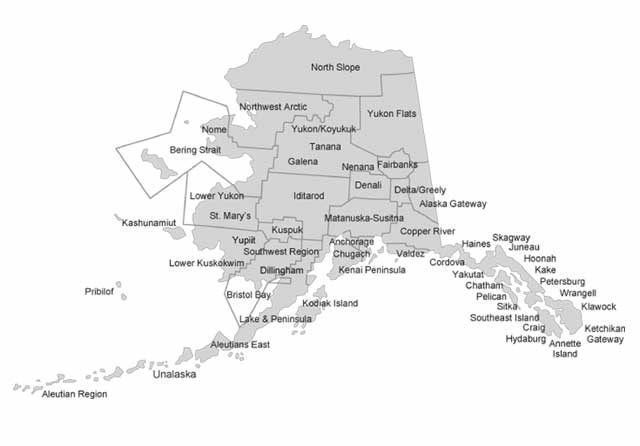How have the ways Alaskans have devised education and health care systems been both a reflection of socio-cultural norms of the dominant culture as well as a response to the challenges of providing services in a vast geographic area?
Alaskans have developed ways of dealing with the two most basic community resources, health and education, in ways as unique as the state. In the early American settlement period the dominate culture of the time used methods that it thought were best and most efficient. An example of this was in 1881 when Commander Glass attempted to improve school attendance by punishing families through fines and humiliating practices. Little, if any, care was taken to understand the cultural background or needs of the indigenous community. Through the questions answered below, more examples of how Alaska's dominate culture coupled with the vastness of geography will be explored.
Unique Health care Challenge

Source: http://www.alaskadispatch.com/article/alaska-hospital-contends-nosey-moose-walking-through-its-doors-video
Examine -
Since the 1870's, what are the types of communities that have evolved in Alaska?
Alaska's development was initiated by two arms, the U.S. Government and extraction based industry.
Government:
The initial U.S. presence in Alaska after 1867 was military and civil service. This is evident when looking at Ivan Petroff's first census. 33,000 indigenous people versus 400+ Americans. As the reading points out, this is to be expected for a fledgling territory. Even though the first colonists were adventure ready individuals some level of government service and protection is needed/expected before fully committing. The first twenty years would see the building of an initial Alaska territorial infrastructure couched in the U.S. military and Treasury Department.
In 1900 the U.S. government, through the military, created the first Alaskan road and telegraph systems. Also, the completion the U.S. built rail line in 1923 provided a stable way to transport large amount of goods and people along its route. Having stable means of communication and trade fueled the creation of settlements along the route. This pattern continues today when looking at population centers in Alaska.
Industry:
Mining would prove to be the turning point in Alaska's development. Today's capital of Juneau began as mining camp. Beyond simple mining camps, Alaska would be an important supply line to the Klondike gold rush of 1898. Towns such as Valdez started as supply camps. Alaska would serve as an important supply line of men and material for inland gold rushes.
Like other industrial states at the turn of the last century, Alaska too utilized the model of "company town." Alaskan canneries would build "towns" for their workers. Between mining the land and the sea, Alaska was beginning to build small population centers that continue to the present.
What role did Sheldon Jackson play in creating an early education system for Alaska?
Sheldon Jackson's role in the creation of an Alaskan education system was that of innovator. Congress' Organic Act gave Alaska the authority and funds to begin an education system. However, the funds topping out at $40,000 in 1885 could not possibly educate all of Alaska. The money may have been enough for other territories but the sheer immensity of Alaska and the lack of infrastructure made it woefully inadequate. Presbyterian Sheldon Jackson was appointed the task of taking these funds and creating a viable education system.
Jackson's innovate solution to spreading thin education dollars across Alaska was both inventive and controversial. Jackson contracted out the education of Alaska's youth to different church organizations/missions. By giving each religion a sphere of influence in Alaska the denominations would be provided a group of potential converts without distraction from competing religious interests while a region of Alaska gained a school, a religious school. This led to the controversial part of Jackson's plan.
American founder Thomas Jefferson is quoted as warning for a "wall of separation" between church and state. The schooling of children, outside the private or parochial school, has been the function of government (local, state, federal). Alaska and Jackson's plan was utilizing federal money in whole or part. This mixing of one man's religion and another man's taxes provided the controversy.
Alaskan School Districts

Source: http://alaskateacher.org/alaska_school_districts.php
How have the health care issues impacted Alaska's Native population?
The indigenous populations have been a central focus in Alaska's health care issues. From small pox and measles to TB the indigenous populations have taken the brunt of casualties from infectious disease. Initially this was do to the lack of exposure to disease bred from large populations in unsanitary urban centers. More recent outbreaks such as influenza and TB have hit indigenous populations because of immunities but also because of the lack of infrastructure and knowledge.
The lack of information and access to care have plagued subsistence villages. The village populations did not have a depth of personnel or resources on hand to deal with outbreaks. Also, their remoteness did not facilitate immediate care when outbreaks occurred. Another roadblock to keeping villages protected from outbreak may be the number of agencies that were created over the years, churches, Revenue Service, Bureau of education, Bureau of Indian Affairs. The multiple agencies/groups all have their own methods and motivations that had to be maneuvered through just to gain access to care and depending on the point of history we are dealing with, the specific agency may have been less than accommodating.
Village Clinic: Diomede

Source:http://www.evlanelli.com/art34.htm
Site Hopper -
No comments:
Post a Comment